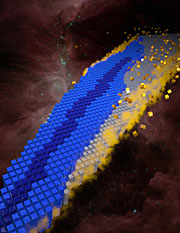- Number 367 |
- July 16, 2012
Jaguar calculations map the nuclear landscape

This image represents the
nuclear landscape, with
isotopes arranged by an
increasing number of protons
(up) and neutrons (right).
The dark blue blocks
represent stable isotopes.
An team from DOE's Oak Ridge National Laboratory and the University of Tennessee has used DOE's Jaguar supercomputer to calculate the number of isotopes allowed by the laws of physics. The team, led by Witek Nazarewicz, used a quantum approach known as density functional theory, applying it independently to six leading models of the nuclear interaction to determine that there are about 7,000 possible combinations of protons and neutrons allowed in bound nuclei with up to 120 protons (a hypothetical element called "unbinilium").
Most of these nuclei have not been observed experimentally.
"They are bound, meaning they do not spit out protons or neutrons," Nazarewicz explained. "But they are radioactive—they are short-lived, because there are other processes, such as beta decay, that can give rise to transmutations."
Of the total, about 3,000 have been seen in nature or produced in nuclear physics laboratories. The others are created in massive stars or in violent stellar explosions.
Earlier estimates of the nuclear landscape varied from as few as 5,000 to as many as 12,000 possible nuclei, Nazarewicz noted. He said his team's calculations were based on the microscopic forces that cause neutrons and protons to cluster into nuclei, adding that results from the six separate models were surprisingly consistent. By using several models, theorists were able for the first time to quantify uncertainties of predicted drip lines.
The team's results are presented in the June 28 issue of the journal Nature.[Leo Williams, 865.574.8891,
williamsjl2@ornl.gov]
